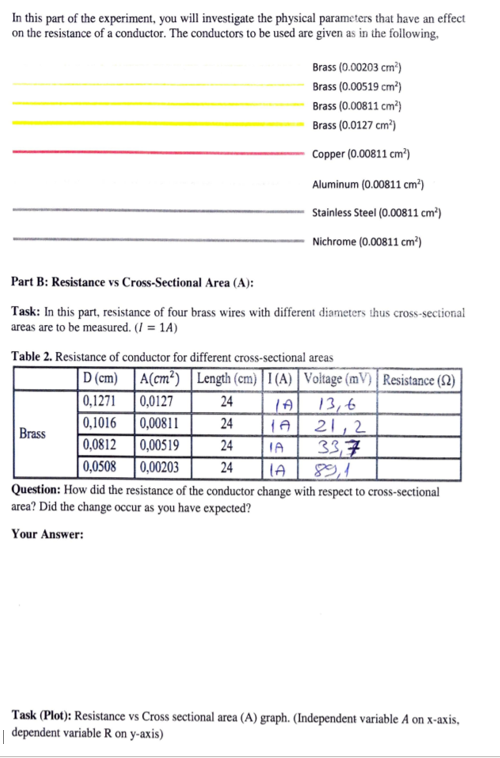In this part of the experiment, you will investigate the physical parameters that have an effect on the resistance of a conductor. The conductors to be used are given as in the following. Brass (0.00203 cm") Brass (0.00519 cm³) Brass (0.00811 cm²) Brass (0.0127 cm") Copper (0.00811 cm³) Aluminum (0.00811 cm³) Stainless Steel (0.00811 cm³) Nichrome (0.00811 cm") Part B: Resistance vs Cross-Sectional Area (A): Task: In this part, resistance of four brass wires with different diameters thus cross-sectional areas are to be measured. (I = 1A) Table 2. Resistance of conductor for different cross-sectional areas D (cm) A(cm²) | Length (cm)| I(A) | Voltage (mV) | Resistance (2) 0,1271 0,1016 0,0812 0,0508 0,0127 24 0,00811 0,00519 0,00203 13,6 TA 21,2 33,7 |(A 24 Brass 24 IA 24 89,4 Question: How did the resistance of the conductor change with respect to cross-sectional area? Did the change occur as you have expected? Your Answer: Task (Plot): Resistance vs Cross sectional area (A) graph. (Independent variable A on x-axis, dependent variable R on y-axis)
In this part of the experiment, you will investigate the physical parameters that have an effect on the resistance of a conductor. The conductors to be used are given as in the following. Brass (0.00203 cm") Brass (0.00519 cm³) Brass (0.00811 cm²) Brass (0.0127 cm") Copper (0.00811 cm³) Aluminum (0.00811 cm³) Stainless Steel (0.00811 cm³) Nichrome (0.00811 cm") Part B: Resistance vs Cross-Sectional Area (A): Task: In this part, resistance of four brass wires with different diameters thus cross-sectional areas are to be measured. (I = 1A) Table 2. Resistance of conductor for different cross-sectional areas D (cm) A(cm²) | Length (cm)| I(A) | Voltage (mV) | Resistance (2) 0,1271 0,1016 0,0812 0,0508 0,0127 24 0,00811 0,00519 0,00203 13,6 TA 21,2 33,7 |(A 24 Brass 24 IA 24 89,4 Question: How did the resistance of the conductor change with respect to cross-sectional area? Did the change occur as you have expected? Your Answer: Task (Plot): Resistance vs Cross sectional area (A) graph. (Independent variable A on x-axis, dependent variable R on y-axis)
Introductory Circuit Analysis (13th Edition)
13th Edition
ISBN:9780133923605
Author:Robert L. Boylestad
Publisher:Robert L. Boylestad
Chapter1: Introduction
Section: Chapter Questions
Problem 1P: Visit your local library (at school or home) and describe the extent to which it provides literature...
Related questions
Question
thanks for help

Transcribed Image Text:In this part of the experiment, you will investigate the physical parameters that have an effect
on the resistance of a conductor. The conductors to be used are given as in the following,
Brass (0.00203 cm")
Brass (0.00519 cm³)
Brass (0.00811 cm³)
Brass (0.0127 cm)
Copper (0.00811 cm³)
Aluminum (0.00811 cm²)
Stainless Steel (0.00811 cm³)
Nichrome (0.00811 cm")
Part B: Resistance vs Cross-Sectional Area (A):
Task: In this part, resistance of four brass wires with different diameters thus cross-sectional
areas are to be measured. (I = 1A)
Table 2. Resistance of conductor for different cross-sectional areas
D (cm) |A(cm²) | Length (cm)| 1 (A) | Voitage (mV) | Resistance (N)
0,1271
0,0127
24
13,6
21,2
33,7
89,1
| 0,1016
0,00811
24
Brass
0,0812
0,00519
24
IA
0,0508 0,00203
24
IA
Question: How did the resistance of the conductor change with respect to cross-sectional
area? Did the change occur as you have expected?
Your Answer:
Task (Plot): Resistance vs Cross sectional area (A) graph. (Independent variable A on x-axis,
| dependent variable R on y-axis)
Expert Solution
This question has been solved!
Explore an expertly crafted, step-by-step solution for a thorough understanding of key concepts.
Step by step
Solved in 2 steps with 2 images

Knowledge Booster
Learn more about
Need a deep-dive on the concept behind this application? Look no further. Learn more about this topic, electrical-engineering and related others by exploring similar questions and additional content below.Recommended textbooks for you

Introductory Circuit Analysis (13th Edition)
Electrical Engineering
ISBN:
9780133923605
Author:
Robert L. Boylestad
Publisher:
PEARSON

Delmar's Standard Textbook Of Electricity
Electrical Engineering
ISBN:
9781337900348
Author:
Stephen L. Herman
Publisher:
Cengage Learning

Programmable Logic Controllers
Electrical Engineering
ISBN:
9780073373843
Author:
Frank D. Petruzella
Publisher:
McGraw-Hill Education

Introductory Circuit Analysis (13th Edition)
Electrical Engineering
ISBN:
9780133923605
Author:
Robert L. Boylestad
Publisher:
PEARSON

Delmar's Standard Textbook Of Electricity
Electrical Engineering
ISBN:
9781337900348
Author:
Stephen L. Herman
Publisher:
Cengage Learning

Programmable Logic Controllers
Electrical Engineering
ISBN:
9780073373843
Author:
Frank D. Petruzella
Publisher:
McGraw-Hill Education

Fundamentals of Electric Circuits
Electrical Engineering
ISBN:
9780078028229
Author:
Charles K Alexander, Matthew Sadiku
Publisher:
McGraw-Hill Education

Electric Circuits. (11th Edition)
Electrical Engineering
ISBN:
9780134746968
Author:
James W. Nilsson, Susan Riedel
Publisher:
PEARSON

Engineering Electromagnetics
Electrical Engineering
ISBN:
9780078028151
Author:
Hayt, William H. (william Hart), Jr, BUCK, John A.
Publisher:
Mcgraw-hill Education,